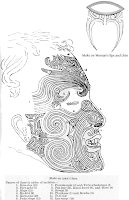
centers on the creation of religious images. The
most recognizable art form from Easter Island are
its colossal stone
figures, or moai, images of ancestral chiefs whose
supernatural power protected the community.Other art forms
on the island include
petroglyphs,
many depicting birdmen
and other
fantastic creatures,
(bottom left)
as well as a
variety of wooden
sculptures (left).
One type of
wooden image,
the naturalistic
male figures known
as moai tangata,
may depict family
ancestors.. With
their enlarged heads, frontal
orientation, prominent
stomachs, and arms
that extend down the
sides of their bodies, both types of image
embody a classically Polynesian conception of the human form.

Easter island cultural art is distinctively Polynesian,
as organic lines and shapes are dominant; possibly as
a reflection of the abundance of water and bountiful
nature of their land (island paradise!). The religious Birdman forms seen here employ
stark contrast as methods of standing out legibly from the rock (top right uses shadows). We can see there is rhythm flowing in the organic lines as they curve and
twist with no apparent straight edges.
Easter island native art stands out among the island crowds with their big stone moais, yet draw their art culture from much of the Polynesian art styles surrounding them, including Tahiti and the Cook Islands. The art
characteristically mirrors the organic beauty of
human and natural forms.

Easter Island art also includes barkcloth images, wooden
ornaments, and featherwork. Apart from the stone figures
and petroglyphs, virtually all surviving works from the
island date to the eighteenth and nineteenth centuries.

SOURCES - www.metmuseum.org/toah/hd/cais/hd_cais.htm
www.escapeartist.com/easter
www.netaxs.com/trance/rapanui.html
www.chiff.com/art/art_history
VERY GOOD LINK - www.janesoceania.com
























 According to Maori mythology the idea of tattooing derives from an ancient story of love. The young man fights with the princess and she goes to her fathers heavens. The man, filled with guilt goes after the princess. After many trials and obstacles he reaches the fathers realm. His face paint being messed th
According to Maori mythology the idea of tattooing derives from an ancient story of love. The young man fights with the princess and she goes to her fathers heavens. The man, filled with guilt goes after the princess. After many trials and obstacles he reaches the fathers realm. His face paint being messed th





